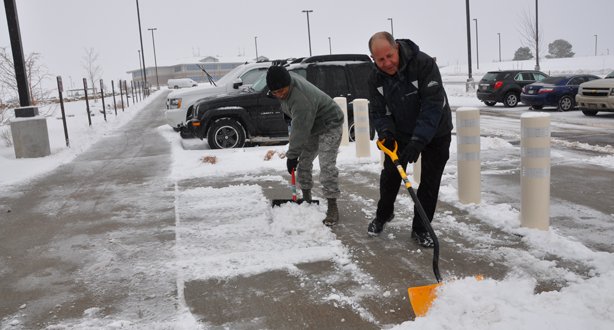The winter months are coming, and along with the beautiful wintery landscapes, the fun of playing in the snow, and the excitement of the Holidays, comes the possibility of slippery roads, dangerous walkways, and icy entranceways. According to the Bureau of Labor Statistics slips, trips, and falls to the same level continue to be one of the main reasons for lost work time injuries. These numbers tend to increase in the winter. The updated OSHA walking-working surfaces rule states that employers must maintain walking-working surfaces and keep them free of hazards such as snow and ice. The same OSHA rule declares that access and egress routes, including sidewalks and parking lots, must also be kept safe (29 CFR 1910.22) and that part of maintaining safe walking surfaces includes keeping them in good repair and correcting any hazard that is found. In fact, when a hazard, such as a deep crack, pothole, or uneven surface is discovered, it must be corrected before the surface is used again. If it can’t be corrected immediately, it must be guarded to prevent anyone from using it until the repair is made [29 CFR 1910.22(d)].” What can you do NOW in order to prepare for winter weather and reduce the risk of employees and pedestrians being hurt by a slip and fall accident in your facility?
Occupational Health and Safety just released an article entitled “Prepare Now to Eliminate Fall Hazards this Winter.” It discusses how safety hazards change with the winter weather coming and how any employer can take proactive actions in order to prevent possible injuries.
- Review incident and near miss reports from the past to see if there was a trend in the type of injuries during the winter. Prepare your employees and managers by discussing these incidents.
- Make needed repairs to physical facility: fix handrails, stairs and sidewalks that may be damaged and check for cracks in sidewalks, uneven outdoor walkways and pot holes. While these may not seem very bad during the summer months, they tend to expand during freezing and thawing cycles, making the tripping hazard much more pronounced. Making sure these features are safe and in good working condition will help prevent injuries during the slippery months.
- Check storm drains and clean out any dirt, leaves or debris that could cause drain back-ups. When a drain isn’t working correctly it can create puddles that freeze and become dangerous.
- Make sure that lighting in parking lots is working correctly and all bulbs are at full strength. With reduced visibility in the mornings and evenings as days are shorter, walking surface hazards are harder to see.
- Review winter maintenance duties with staff and make sure that there is enough support to get all tasks accomplished. The article suggests varying their schedules in order to meet all of the maintenance needs and in order to minimize over-time.
- Discuss the snow and ice removal duties if there is an outside vendor responsible for plowing and clearing parking lots and walkways. Make sure that everyone is on the same page and get a written contract on specific duties.
- Don’t procrastinate on buying shovels and ice melt products. Get them now before they are needed and in shorter supply! Be sure to place them strategically throughout the facility to ensure that employees can access them when needed.
- Tune-up snow blowers, snow removal vehicles and any other machine used for winter maintenance. Be sure that they are in good working condition and you have any common replacement parts in stock as well as enough fuel stored.
- Be sure to have caution tape or barricades in easily accessible locations in case a walking area needs to be closed due to a hazard.
- Floor fans and absorbent mats are important to have in stock and in working condition in order to quickly resolve a slippery entranceway.
- Start early by talking to employees about the slippery winter months even before the season begins. Post information about ice and snow safety throughout the facility.
- Distribute snow gear and proper feet protection for those employees that will spend a lot of time outside in the elements.
SLIPNOT safety flooring products and surface technologies are also a great way to reduce the chance of slip and fall injuries during the winter. While the products must be clear of snow and ice in order to work properly, the high traction surface will help keep employees on their feet in a wet environment. Slip-resistant plate, grating, and treads are a durable long-lasting solution to slippery flooring.
By taking a look at all of these ways that your facility can prepare for winter and by considering installing a permanent high traction safety product in slippery areas, your employees can be sure that you have their best interests in mind as the snow comes down.
—
Hamel, Karen D. “Prepare Now to Eliminate Fall Hazards this Winter.” http://www4.ohsonline.com November 1, 2017. November 15, 2017.




